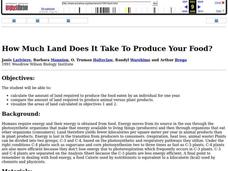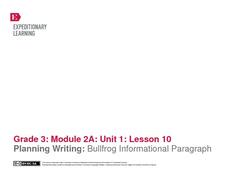Curated OER
Precious Water: Is it a Need, a Right, or a Commodity?
Young scholars determine whether water is a need, a right, or a commodity. In this water lesson, students investigate land and water ecosystems through activities. Young scholars also discover water as a resource and energy source as...
Curated OER
Baby Animals
Students study baby penguins and whales. They name the penguin body parts and examine how penguins hatch from eggs. They name whale body parts and their function. They participate in a whale role play activity.
Curated OER
We're Zoologists!
Students listen to story, "Never, Ever Shout in a Zoo," by Karma Wilson, practice finding information from Internet, write information about one chosen zoo animal, draw picture of their zoo animal, pair up and read their My Zoo Animal...
Curated OER
How Much Land Does It Take To Produce Your Food?
Students calculate the amount of land required to produce the food eaten by an individual for one year. They compare the amount of land required to produce animal versus plant products. Students visualize the areas of land calculated.
Curated OER
Go To Sleep, Gecko!
Second graders examine the interdependence of organisms using the book "Go To Sleep, Gecko!" They examine a variety of food chains, listen to the book, and answer story comprehension questions. Students then conduct research on food...
Messenger Education
Mission: Possible—How Can We Plan an Exploration of Another World?
An astronaut's spacesuit weighs 280 pounds and takes 45 minutes to put on — that's a serious suit! The second activity of a three-part series allows pupils to see all that goes into space exploration. Through simulations, groups analyze...
EngageNY
Planning Writing: Bullfrog Information Paragraph
Lesson ten in this unit for the book Bullfrogs at Magnolia Circle, prepares third graders to begin writing an informational paragraph about the adaptations of bullfrogs. First, young writers work either independently or in pairs to...
Curated OER
Variation
In this animal habitat worksheet, students read the clues about the animal environments. Students then write or draw each of the animals in the right space. Students find the habitats for trout, a bird, a human, and an earthworm.
National Science Teachers Association
Hop into Action
Young scientists find out what makes amphibians such unique and interesting animals in this simple life science lesson plan. After looking at pictures and discussing the characteristics of amphibians, learners complete a series of three...
Curated OER
Hatched From An Egg
Students discover how animals are born/hatched. For this life science lesson, students listen to a book entitled Chickens Aren't The Only Ones, and discuss animals that are hatched or born. Students receive a picture of an animal, they...
Curated OER
What Makes a Tropical Rainforest Special?
Students examine the characteristics of the tropical rainforest. Using a map, they locate the rainforests found around the world, continents and the equator. Using the internet, they research the various layers of the rainforest and...
Curated OER
Plant Lifecycles
Students examine the life cycle of plants. In this plants activity, students identify the various stages of plants and their parts. Students compare the life cycle of a plant with that of an animal. Activities suggested can be modified...
Curated OER
Which Animals?
In this animal comparison worksheet, students will fill in a Venn diagram comparing and contrasting the Sabre-toothed tiger and the Bengal tiger.
Curated OER
Which Animals are Invertebrates?
In this invertebrate worksheet, students will complete a chart for 6 different animals, deciding if that animal has a backbone or not and if it is a vertebrate or invertebrate.
Curated OER
Lesson 1 - What Are Fossils?
Students define and research fossils. In this fossil lesson, students access teacher assigned Internet sites to examine images of fossils. They determine the definition of a fossil and find out how fossils are formed. They also define a...
Curated OER
Force of Habitat
Learners examine the Nevada state quarter and discuss the Great Basin and the desert habitat. They draw a desert animal and write a sentence about its attributes and how they help the animal to survive in its habitat.
Sea World
Ocean Discovery
Immerse your young marine biologists in the world of marine animals. The lesson plan includes several activities that are age-appropriate for preschoolers and kindergartners, including coloring pages, gluing feathers and sand onto paper...
Teach Engineering
All Fats Are Not Created Equal
Apply robotics to connect physical properties to chemical properties. Future engineers use robots to determine the melting points of various fats and oils. The robots can do this by measuring the translucency of the fats as they heat up.
Curated OER
How Are Offspring Like Their Parents?
In this parent and offspring worksheet, students complete a graphic organizer by writing in 1 idea and 2 supporting details about how offspring are like their parents.
Curated OER
Match One to One
In this matching pictures learning exercise, students must recognize the animals and then draw lines to match the like animals one to one.
Curated OER
Cells are 3-D!
Students design three dimensional models of plant and animal cells. They identify the cells parts, and compare animal and plant cells.
Curated OER
It's not just pretty - it's a survival method!
First graders write explanations for why certain animals can only live in certain environments. In this animal survival lesson plan, 1st graders take pictures of animals and place them into the right environment after a lesson plan on...
Curated OER
Two Way Causality in Ecosystems
Students complete various activities in order to explain that ecosystems are complex and that animal behavior (mainly that of a predator) is not necessarily intentional or bad.
Curated OER
How Do Animals Grow and Change?
In this animal growth worksheet, students will write in the 3 steps in a salamander's life cycle, from egg to adult. This worksheet is a graphic organizer.

























